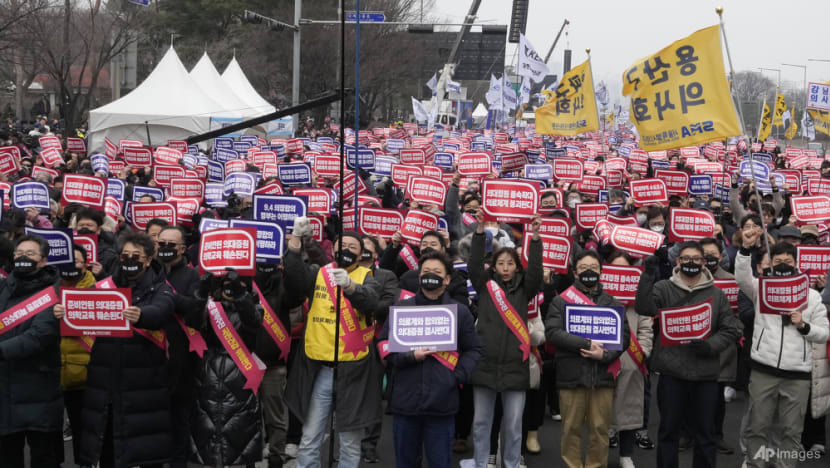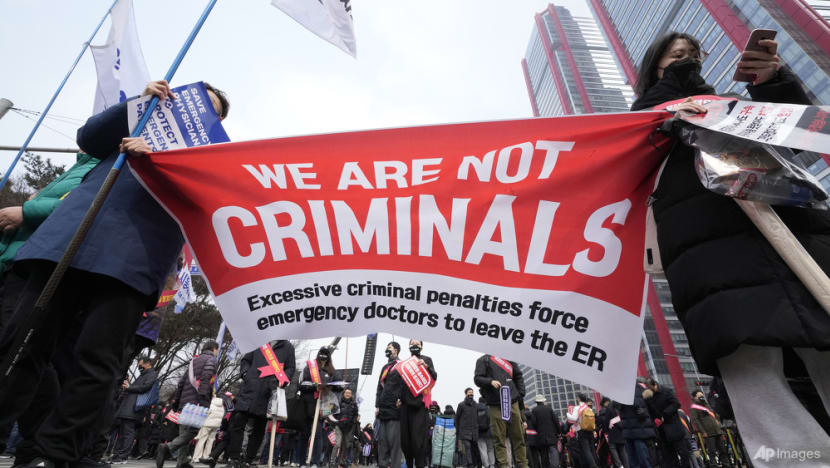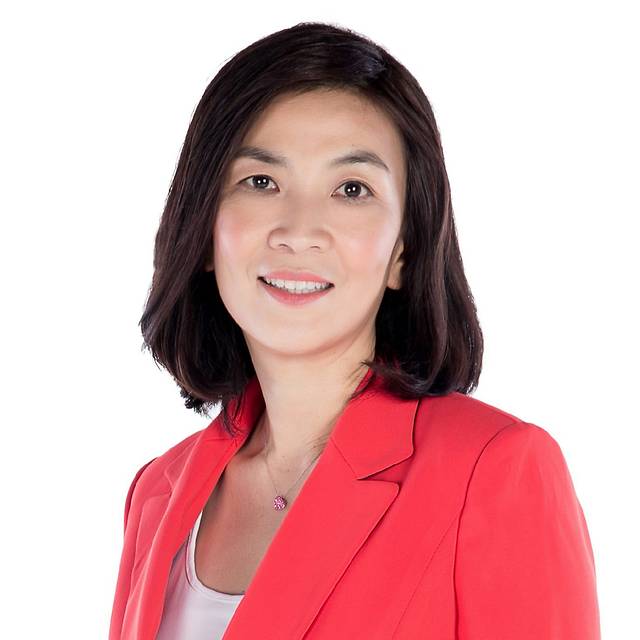‘We'll continue our struggle’: South Korea’s doctor strike crisis deepens as more join walkout
A prolonged walkout could invite increasingly severe public criticism towards both the government and striking doctors, said analysts.

Doctors stage a rally against the government's medical policy in Seoul, South Korea, on Mar 3, 2024. (File photo: AP/Ahn Young-joon)

This audio is generated by an AI tool.
SEOUL: South Korea’s healthcare crisis deepened this week as senior doctors and medical professors joined a protracted strike to protest increasing medical school admissions.
Since February, more than 12,000 junior and trainee doctors have walked out on hospitals over the government's reform plans aimed at addressing a shortage of physicians in the nation.
The Korean Medical Association (KMA) on Tuesday (Jun 18) led a protest in Seoul with thousands of doctors. They included private practitioners who participated in a one-day solidarity strike.
This came a day after more than 500 medical professors at Seoul National University public hospitals walked off their jobs on an indefinite strike.
Some medical students have also either delayed their enrolment or boycotted classes, saying the government’s plan will affect their careers as doctors once they graduate.
The months-long strike has led to unprecedented disruptions in the nation’s healthcare system as both sides refuse to budge.
Public anger has been simmering as overwhelmed hospitals are forced to turn away patients amid the doctor shortage.
Observers urged all sides to negotiate amicably, saying a prolonged walkout could invite increasingly severe public criticism towards both the government and striking doctors.
THE POLICY REFORM
South Korea has among the fewest doctors per capita in developed countries. Its rapidly ageing population is expected to exacerbate the scarcity.
Authorities have forecast an acute shortage of doctors in the nation in the next decade.
President Yoon Suk Yeol’s administration wants to grow the number of doctors by sharply raising the annual medical school enrollment quota by 2,000.
Doctors have argued this will not solve the fundamental problems facing the healthcare system, and that the quality of the nation’s healthcare services would suffer.
“Their stance is that the shortage of doctors is not an issue at the present time and instead, they need changes to their working hours, which are considerably longer than average,” said Mr Rob York, director of regional affairs at foreign policy research institute Pacific Forum.
South Korean doctors often work more than 100 hours a week, compared with their counterparts in the United States who average about 60 hours, according to the Korean Intern Resident Association.

KMA – the country’s main doctors’ lobby group – said about 74 per cent of its members voted in approval of the collective action to strike.
“Our junior doctors and medical students were the ones who started and maintained this struggle. Now, it is time for senior doctors led by the KMA to rectify this situation,” said the association’s spokesperson Anna Choi.
KMA’s deputy spokesman Chae Dong-young told CNA that striking doctors will see no reason to return to work if the government “continues to show no willingness to engage in dialogue”.
“We will continue our struggle, and it is likely that the intensity of our actions will increase beyond the current level,” he warned.
OPPOSITION, PUBLIC SUPPORT REFORM
The main opposition Democratic Party, as well as an overwhelming majority of the South Korean public, support the government's quota hike for medical students and oppose the ongoing strike.
Nearly 86 per cent of respondents in a poll by Yonhap News Agency earlier this month called on doctors to return to hospitals, while 65 per cent said authorities should proceed with the increase in medical school placements.
Health, economic and policy professor Soonman Kwon from Seoul National University said it is a “rare situation” when the two main political parties agree on a policy, reflecting the severity of the doctor deficit in the nation.
However, he said authorities need to reexamine the policy with stakeholders and find a middle ground.
“Although the public supports the plan, such a large increase – 2,000 – is a bit too much. Around 1,000 or less might be more reasonable,” Prof Kwon told CNA’s East Asia Tonight programme on Tuesday.
“The government needs to slightly change its position and should show willingness to talk with … doctors, the association, the public … and agree on a (viable) number. If this strike takes too long, public sentiment may change,” he added.
However, observers acknowledged it will not be easy to reach a compromise.
“The primary issue is that the KMA has simply been recalcitrant all this time. They are not willing to change their overall position and simply not willing to negotiate on this matter,” said Mr York.
FAIRER DISTRIBUTION OF DOCTORS
Observers said there is also a need to ensure more balance in the distribution of doctors in different locations and across specialisations.
Pay in some critical fields – including emergency, life-saving surgeries and specialist care – is far lower compared with non-essential but high-paying fields like cosmetic and aesthetic procedures.
The disparity in compensation and infrastructure between urban and rural areas also means doctors are mostly flocking to lucrative roles in bigger cities, leaving parts of the country in desperate need of physicians.
“An increase in the supply of doctors cannot automatically guarantee solving the inequity issues,” Prof Kwon said.
“However, without increasing the supply of doctors, the inequities can never be resolved.”
Meanwhile, effects of the walkout have also spilled over to other sectors within the healthcare industry.
Nursing graduate Ashley Kim was offered a job as a nurse at one of South Korea’s largest hospitals when she completed her studies in February.
However, the 24-year-old has been left in limbo as hospitals delay new hires due to the ongoing strike.
“Initially, I was excited after learning that I got the job, but now I am just waiting without knowing when I can start and so I am feeling anxious,” she told CNA, adding she hopes the doctors will return to work soon.


















